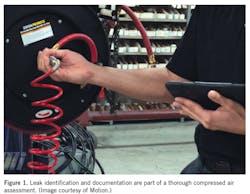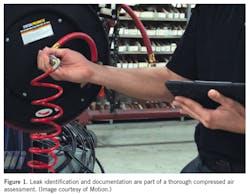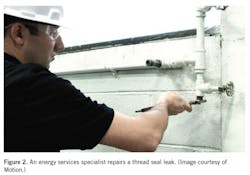Don't accept costly compressed air leaks. Fix them.
The constantly evolving world of technology, predictive maintenance and the Internet of Things (IoT) has changed how we analyze, plan for, and react to problems. Nonetheless, this has not changed our dependence on traditional technologies, specifically compressed air—an easily accessible energy source. Because it can be cost-effectively deployed using piping or hose, it is common to add compressors to create additional compressed air volume. The compressors are added to the compressed air system’s existing “supply side” to meet a plant’s need for additional compressed air energy. In most cases, this is due to a rising waste rate from neglected air leaks as opposed to an actual production increase.
With the high cost of compressed air generation (supply side), compressed air consumers’ (demand side) waste must be identified, reduced, and kept at a manageable level. The U.S. Department of Energy states that almost 50% of compressed air energy is wasted, making leaks a common and well-known aspect of any compressed air system. Unfortunately, they are often overlooked because leaks may not directly affect production and are not considered a priority. As a result, leaks become commonplace and thus accepted in most manufacturing facilities. The Compressed Air and Gas Institute (CAGI) states that an acceptable leak load is 8% of demand. Yet, in my auditing experience, without a leak remediation plan, the leak load is almost always much higher than the stated acceptable standard.
One of the most common problems I hear in almost all manufacturing facilities throughout the country is a shortage of skilled tradespeople. This can result from general budget cuts, lack of quality, or a shortage of experienced candidates or staff, with the latter due to the silver tsunami of maintenance people retiring. This, in turn, forces facility personnel to prioritize their workloads. Consequently, compressed air leaks are moved further down the “to-do” list.
The challenges manufacturing faces today not only concern identifying the high cost associated with leaks, but also scheduling and budgeting for repairs. The example I will share is from a recent survey of a bottling facility in the food and beverage industry, which excites me as a big advocate of all things “food and beverage.” So not only am I a concerned business partner, but just as important, I am also a concerned consumer looking to help quantify, analyze, and reduce the facility’s wasted demand.
Through our partnership, the facility engaged the Motion Energy Services Team (EST) to perform a thorough compressed air assessment of both the system’s supply and demand sides (see Figure 1). Using ultrasonic detection, a comprehensive leak identification study was conducted. This process involves tagging, photographing, and carefully documenting each leak. The leak location, thread or port size, component description, cost based on the estimated waste, and the replacement recommendations are all noted. This information is entered into a spreadsheet and can be sorted many ways, including by department, leak size or ease of implementation. This facility was 350,000 square feet, and the leak detection process took two days.
Once the leak list was submitted and the total potential savings were presented, the facility expressed interest in outsourcing the leak repairs to a third-party contractor because of internal labor restraints. The Motion EST partnered with a qualified preferred contractor with an existing relationship with the facility. This was ideal, as the contractor was already familiar with the plant operation and personnel. The EST helped manage the replacement parts order, sorting the received components, and liaising with the facility and the contractor to ensure full transparency, yielding a successful project. The repairs took close to two weeks as the contractor worked around the facility’s production schedule. The contractor kept detailed notes of the repairs and even helped identify and fix more leaks than were originally documented (see Figure 2).
As a result of the survey, even after the cost of parts and contracted repairs were considered, the facility saved $70,605 in the first year, with a seven-month return on investment (ROI). This was achieved with minimal use of facility resources.
In this example, the facility had the necessary backup compressors on-site with the required compressor output capacity to maintain pressure despite a sizable leak load. This is not always the case, as excessive waste can lead to large problems, such as pressure loss and potential production issues when all available air compressors can no longer maintain demand. I have been brought into several situations where the customer was forced to rent a diesel compressor to maintain pressure. Rental compressors have a high monthly fee, and with the price of diesel fuel, the cost of daily operation can be exorbitant. Most of these rental units have manual control and will run continuously regardless of air amount produced. Compressor redundancy and prioritizing leak repair are all required steps to prevent this level of unnecessary spending.
Leaks remain a natural part of manufacturing and are considered a cost of doing business. Routine leak detection is necessary to keep the leak load manageable, as leaks will forever be present in any compressed air system. An internal quarterly leak detection and repair campaign is recommended to help keep the labor requirements under control. Changing the culture and instituting a routine compressed air leak repair program will help convey the importance of waste remediation. This can be achieved by investing in the necessary equipment and finding the right partner to train internal staff. Training would cover using the leak detection equipment and managing the repair process to capture the identified savings.
See compressed air leaks with acoustical imaging
Leak detection equipment includes ultrasonic technology, which has taken a drastic step forward by introducing the acoustic imager. This tool measures the decibel levels that a compressed gas emits and converts them into an image. Although some training is required, it has greatly reduced the overall learning curve, making this an ideal solution for skilled-labor shortages.
The lesson is that limited internal resources are a real issue. However, you can still reduce your carbon footprint while achieving a healthier bottom line. When it comes to compressed air leaks, accepting them as the norm is like ignoring personal debt. Not taking action can result in an exceptionally high cost of operation. Meet your compressed air energy remediation goals by streamlining your internal process and/or by working with your energy reduction vendor partners. Challenge your business partners to create solutions while utilizing them to manage the project to completion. These partnerships help attain real savings while also reducing the heavy strain on your plant’s maintenance team.
This story originally appeared in the February 2022 issue of Plant Services. Subscribe to Plant Services here.
Mike Kusch is energy services manager at Motion. He has performed and provided deliverables on hundreds of compressed air energy surveys across North America in a wide array of industries for almost 10 years. To find out more, visit www.motion.com/plantservices.


